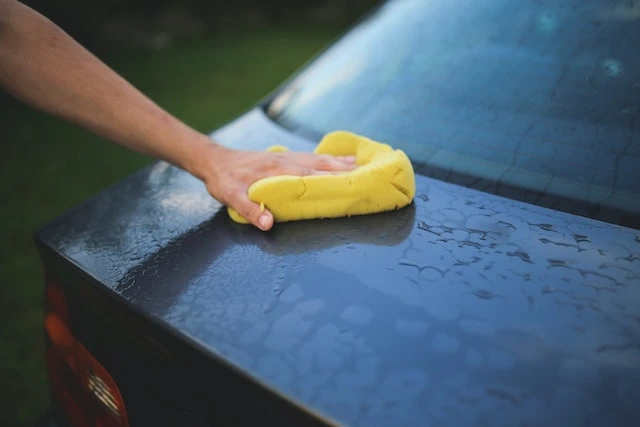Regularly cleaning your car is essential for preserving its condition and value. Washing it at home saves time and money but may not provide the same service quality. If you need a deep clean, going to a car wash is the way. Read how to use a car wash and get the most out of the experience.
Follow Some Essential Steps Before You Go To the Car Wash
Before heading to a car wash, it’s crucial that you properly prepare your vehicle for the experience. First, remove any items inside the car that could be damaged by water or harsh chemicals. You might also disconnect the car alarm if it’s easily triggered.
Anything that can’t be removed should be covered with plastic wrap or sealed in plastic bags. Make sure all windows are rolled up, and doors are securely closed so no water can leak into the car interior during washing.
You’ll also want to secure any loose items attached to the exterior of your vehicle, such as antennas or bike racks; these will need to be removed before entering the car wash tunnel.
Step 1: Preparation For the Car Washing Process
Step 1: Preparation For the Car Washing Process
The first step in using a car wash is preparation. You will want to remove any personal items from your vehicle that could get damaged or lost during the wash process, such as floor mats, sunglasses, or even loose change.
Additionally, ensure any loose parts of the exterior of your vehicle are secure before entering the car wash. This includes antennas, hubcaps, and other detachable pieces that could become damaged due to the pressure of water or scrubbing brushes.
Step 2: Preparing Your Vehicle for Washing
Once you have everything secured and removed from your vehicle’s interior and exterior, you may need to give it a short rinse before entering the car wash. This should be done only if you have a hose available and the car has gone through some deep mud or dirt.
If necessary, use a hose with a sprayer attachment to remove dirt and debris from your vehicle’s surface; this helps prevent scratches when scrubbing your car with professional tools and when going through automatic washes.
If you notice bird droppings and stains here and there, don’t worry – you’re going to the car wash to remove them, so there’s no need to actually clean your car before it gets cleaned (if you catch my drift).
Step 3: Entering the Car Wash
Once you’re sure everything is out of the way, all loose parts are securely fastened back in place, and the car’s ready to enter the car wash, go ahead and enter.
Begin by inserting coins into the coin machine – or swiping your card if you purchased an unlimited pass – and then follow all instructions provided on signage throughout the carwash facility until you reach the entry point with all the washing supplies available for a wash.
You can wash your car by yourself or get help from an attendant. They’re there to help you clean your car thoroughly and with care; if you don’t know how to do it, you’ll be given instructions.
Here’s What to Do During and After Your Car Wash
Once all these steps are taken, you’re ready for the car washing process. Depending on your budget, you can purchase various services like high-pressure washes and waxing treatments at most car washes, especially automated ones.
The higher-priced packages typically offer more comprehensive options than those included in basic packages; they may have extra rinses, drying agents, and more specialized services like wheel cleaning and spotless undercarriage washes.
Additionally, many car washes feature additional amenities like vacuums for interior detailing and air fresheners for an added touch of luxury after each visit.
Types of Washes
There are plenty of different types of washes available depending on how much cleaning you want to be done on your vehicle.
Most modern car washes offer several options, such as basic washes with just soap and water and more advanced options that feature additional steps like waxing or polishing.
In addition, some car washes may offer extra services like wheel cleaning or detailing packages if desired. Ensure to research which type is right for your needs before getting started.
What to Do During The Washing Process
If you’re at a regular, non-automated car wash, you’ll be instructed on using the cleaning tools. In the automated car washes, there are instructions posted inside on how to proceed with the wash process.
Generally speaking, though, all you have to do is drive forward slowly while keeping an eye out for any potential obstacles that may be in front of you (like other cars). Make sure not to stop suddenly during the process – this can cause damage to brushes and might even stall the machine.
Once finished with the wash cycle, move forward until told otherwise by either signage or an attendant at the end of the line.
Steps to Take After The Wash
After exiting from the car wash tunnel or drying area, it’s time for one final check before calling it a day. Give your vehicle one last inspection for dirt spots that may have been missed. Pay special attention to wheels since they tend to collect dirt easier than other areas – and wipe away any remaining moisture with a chamois cloth if necessary.

Pros and Cons of Car Washes vs Home Washing
When it comes down to it, there are pros and cons associated with both visiting a professional car wash and doing it yourself at home. Taking your vehicle to a professional service ensures your vehicle is receiving an excellent level of care.
Washing your vehicle at home eliminates added expenses while allowing total control over what products are used on your paint job. With that, you can also do other maintenance, like adding brake fluid, potentially swapping winter and summer tires, and maybe replacing the tail lights if needed.
The Pros and Cons of Using a Car Wash
Using a professional car wash has its advantages and disadvantages when compared with washing your vehicle yourself.
On the one hand, when using a professional car wash, you can rest assured knowing that your vehicle is being washed by professionals who know what they’re doing and have access to high-quality cleaning solutions.
On the other hand, going through that process, whether automated or manual, means you might not get as thorough of an overall cleaning as if you were doing it yourself manually.
The Pros and Cons of Washing Your Vehicle at Home
If you want to get similar results from home as from a professional car wash without spending too much money on specialized equipment or solutions, there are several things you can do to get an effective clean without breaking the bank.
Start by using only high-quality soaps (either liquid or powder) designed specifically for vehicles; look for ones with anti-static qualities so that dirt doesn’t stick to your car after rinsing off soap residue.
Additionally, rinse thoroughly with clean water after every step so that soap residue does not stay behind and cause further damage down the line. Finally, use only soft cloths when drying off and avoid rubbing too hard so as not to scratch off any protective coating on your vehicle’s exterior surfaces.
This at-home recipe can also help you do other things, like clean the steering wheel as well as scrub the seat belts. It’s not just what’s on the outside that counts; you should also pay attention to the inside.

Home Car Wash: How to Do it Right
Washing your car at home can be a great way to save money and give your four-wheeler a personal touch. But how do you wash your car to get a result similar to taking it to a professional?
Here, I’ve covered all the tools you need, the steps you should take, and some tips for a more efficient cleaning process.
What You Need For Your Home Washing Process
To ensure you properly and thoroughly clean your vehicle, you will need the following items:
- Bucket – A large bucket is best so that you can mix the soap and water in it,
- Sponge or wash mitt – Avoid using scrubbing brushes as these can cause scratches,
- Car soap – Look for car-specific soaps; these are specially formulated for use on cars,
- Chamois cloth – To dry your car off after washing it. If you don’t have one, an old towel will do in a pinch,
- Hose – To rinse off the soap from the car. A pressure washer is also an option if available,
- Wheel cleaner – If you want to clean your wheels properly, you will need either a wheel cleaner or some dedicated elbow grease (or both),
- Wax – Applying wax after washing will help protect your paintwork from dirt and grime build-up in future washes and keep it looking new for longer.
The Step-by-Step Process
Now that you have all your tools, check out what steps to take when cleaning your car at home.
Pre-rinse the vehicle with water from a hose or pressure washer before applying any soap or cleaners to remove loose dirt and debris from the vehicle’s surface. Then, mix up some car soap in a bucket of warm water.
Using either a sponge or wash mitt, start washing one section at a time with soapy water, rinsing each section with clean water as you go. Once complete, dry off each area with either a chamois cloth or an old towel, and clean any wheels with either wheel cleaner or dedicated elbow grease.
Finally, apply wax to protect against future dirt build-up.

Tips for Efficiency When Cleaning Your Car At Home
Cleaning your car at home is cost-effective and gives you control over how much effort goes into giving your ride that showroom shine. With proper care, knowledge of what tools are necessary, and following my tips, you should be able to take care of everything easily.
Here are some tips you can follow and write down for a more efficient cleaning process at home:
- Use two buckets, one for soapy water and one for rinsing,
- Start from the top down rather than the bottom up,
- Rinse often,
- Use microfiber towels instead of sponges,
- Don’t leave suds on the surface of your vehicle,
- Don’t allow any cleaners/soaps to sit on paintwork too long,
- Make sure all cleaners/soaps are applied correctly,
- Work in small sections,
- Use circular motions when washing,
- Don’t forget about glass surfaces,
- Avoid direct sunlight while cleaning,
- Make sure all surfaces are dry before applying wax.

Take Your Car to the Wash or Simply Scrub It Down Yourself
Ensuring your vehicle receives regular maintenance is key to keeping its value high over time. Whether this entails taking it through an automated car wash tunnel or doing some DIY detailing work at home matters less than ensuring satisfactory results.
Regardless of how you care for your ride, following these simple tips will ensure its sparkling clean exterior lasts long into the years ahead. So remember – when considering how best to take care of that prized possession parked outside, weigh all options before making a final decision about where (or how) best to show it some love.








